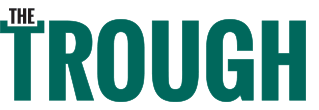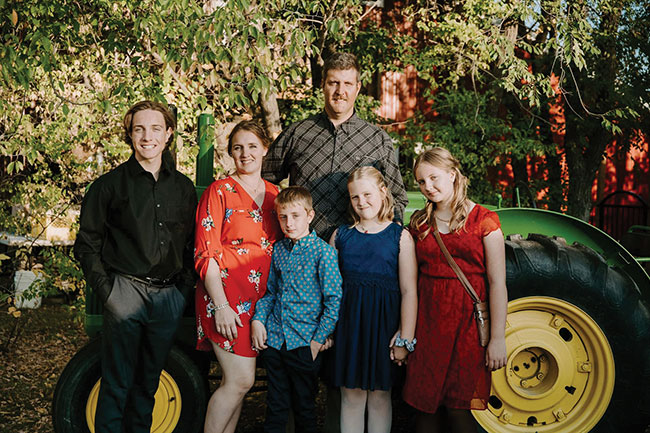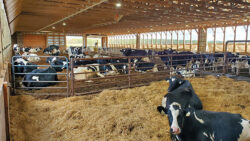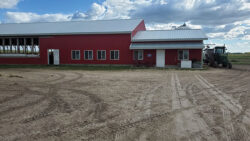
Features
Farm Focus
Quality is key
By Julienne Isaacs
Richard and Kristy-Layne Carr give insights into their herd’s nutrition plan
 Richard Carr, back, and Kristy-Layne Carr, second from left, grew their farm while they were growing their family.
All images courtesy of Rich Lane Farms
Richard Carr, back, and Kristy-Layne Carr, second from left, grew their farm while they were growing their family.
All images courtesy of Rich Lane Farms Richard Carr was only 12 when his parents sold their family farm in southern Manitoba and he moved into town.
But farming was already in his blood.
As a teen, Carr worked part-time at dairy farms while completing high school. Later, he worked as a herd manager for 13 years on a dairy farm. “That’s where I got into the rhythm of dairy nutrition,” he says. “I worked closely there with nutritionists and veterinarians.”
These days, nutrition is always front-of-mind at Rich Lane Farms, which Carr owns with his wife Kristy-Layne. In 2022, the Carrs were named Manitoba’s Outstanding Young Farmers of the year. It was a sign of how far they’ve come as a family and as farmers.
Kristy-Layne’s education is in agronomy and animal science, and her family farming background is in grain and beef cattle. When the couple married in 2006, they started a hobby farm with a few beef cattle from Kristy’s 4H days on his home quarter in La Broquerie. Both worked off-farm to make ends meet while they gradually grew their herd to 250 head and expanded their acreage.
They also grew their family, adding children Slade (now 15), Elora (12) and twins Nate and Isabel (nine).
But they wanted to farm full-time, so something had to change.
In 2018, the Carrs were chosen for Dairy Farmers of Manitoba’s New Entry Program. They sold off a lot of their acreage and most of their beef herd, retaining 60 of their Black Angus commercial beef cattle, and added a milking operation. These days, they milk 55 dairy cows in a double eight milking parlour.
Nutrition plan
The cornerstone of the Carrs’ nutrition plan for both herds is forages.
“The fundamental premise of all the diets on the farm is to focus heavily on the forage itself, producing the most high-quality forage we can. The base ingredient of all the rations is corn silage,” says Carr.

The Carrs’ cows enjoy a diet that includes corn silage and rye (dairy) and Japanese millet (beef).
All images courtesy of Rich Lane Farms
The Carrs sideline as seed dealers for Horizon, and grow Horizon silage corn with good digestibility, meaning high starch and lower lignan, he adds.
They also grow forages, mostly ryegrass, as well as Japanese millet, alfalfa and forage oats. They cut fall rye for silage in early June, and the crop has worked really well for them, says Carr.
“Corn silage and rye is the basis for our dairy cows. The first cut of our common annual rye usually will be used for young stock on the dry cows in the dairy. [The] second and third cuts have higher feed value and go to the milking cows,” he says.
The alfalfa can be trickier: it has potential to be really good, but it’s pricier and winterkill has been an issue in the area, says Carr. “We have quite a few hog barns in the area, too, and [use] hog manure is a nutrient source. Hog manure application timing in alfalfa is critical–three or four days too late has impacted the stand. We typically apply right after the first or second cut, before too much regrowth has come back.”
Japanese millet has served them well too: it’s hardy and has grown well both under excess moisture and drought conditions over the last couple of years. They’ve used it for their beef herd. There is a caveat, though: its protein content is lower, says Carr.
“Nutritionally speaking, we haven’t had the high protein content as we’ve had with fall rye. [With] fall rye we can get up to almost 21 per cent protein, and the common annual rye last year was 22 per cent protein. The millet is [around] 12 to 16 per cent. The Digestible Neutral Detergent Fibre is a little higher on the millet so it’s not as digestible. But it’s still a very good feed for us,” he says.
Supplementing when necessary
It’s important to the Carrs to produce as much of their animals’ diet on the farm as possible, but they do use supplements when necessary.
“Our end goal is to use as few purchased commodities as we can for the makeup of our milking cow diet. They produce the milk that pays the bills, but they require the most nutrition,” he says.

The Carrs are hoping to hit a balance of 72/28 per cent forage and supplement diet for their herd this spring.
Their goal, in general, is to use 70 per cent forages, 30 per cent supplements; they’ve hit that goal in the past. This past year they reached 68/32.
“This spring, I’m looking to push that goal further and hit 72/28. Soon we’ll go into last year’s third-cut rye and that tested extremely well. I’m hoping to keep the production where it’s at and reduce our supplements,” he says.
Occasionally, when growing conditions aren’t ideal, they have to rely more heavily on supplements.
“Our feed quality has to be very high. We’ve lost acres because of standing water and our corn wasn’t where we wanted it to be–not enough starch to it. So in the purchased supplement, we increased the starch so we had enough total starch in our diet,” he says.
The Carrs rely on frequent, broad testing of their bale silage to ensure the herds get the right percentages. Once they start feeding, if cows aren’t milking to what they sampled for, they’ll sample again. Because corn silage ferments over time and can change a bit, they sample that every two to three months.
“A lot of that is just watching your production and your cows. This time of year, when it’s very cold, the cows may need more energy, so we monitor the cows and adjust the nutrition to match their requirements,” says Carr.
Self-reliance has its merits, but the Carrs know when it makes most sense to pull in external resources. This principle plays out in another key area on the farm–equipment.
The only tractors the Carrs own are a skid steer, a tractor for bedding and one for snow clearing. As far as field equipment goes, Rich Lane Farms relies on custom operators for planting, spraying, harvesting, cutting and baling.
“The only thing I’ll do on the forage side is to haul the bales home and for corn harvest, the custom chopper comes, hauls to the yard, and then I pack the silage pile,” says Carr. “We have a good relationship with our custom operators and we work very closely on timing. When I grew up on my parents’ dairy farm, they milked 70 cows and equipment shared with my grandparents, and [harvest took a week]. Now we do the same acres, the custom chopper comes in, does 10 rows at a time and does my corn in an afternoon.”
Times have changed, but one thing hasn’t: the Carrs’ love of farming and the land.
Print this page